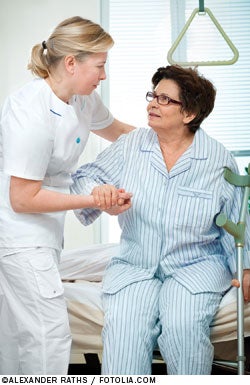Bed alarms fail to reduce patient falls
 Hospitals seeking a way to eliminate or reduce patient falls need to do more than install bed alarms, according to recently published research.
Hospitals seeking a way to eliminate or reduce patient falls need to do more than install bed alarms, according to recently published research.
Bed alarms do not decrease patient falls and related injuries, according to the findings of a study conducted by researchers at the University of Florida and two other U.S. universities. The findings were published in the November Annals of Internal Medicine.
"The idea that hospitals can magically eliminate the problem of falls by investing a lot of money and effort into bed alarms is not well-founded," says lead researcher Ronald Shorr, M.D., professor of epidemiology in the University of Florida College of Public Health & Health Professions and College of Medicine. He also serves as director of the Geriatric Research, Education and Clinical Center at Malcom Randall VA Medical Center, Gainesville, Fla.
Shorr, and colleagues at the University of Tennessee and Vanderbilt University, conducted a clinical study of nearly 28,000 patients at Methodist University Hospital, Memphis. The 18-month study involved 349 patient beds in 16 general-medical, surgical and specialty units.
The alarm, made of weight sensors embedded into a flexible pad, could be placed on a bed, chair or toilet. When the patient's body breaks contact with the sensor, a noise alerts the nurse.
In one group, nurses were given educational materials and trained to use the bed alarms. Technical support providers also promoted use of the alarms and helped with setup and troubleshooting. In the second group, bed alarms were made available, but their use was not formally promoted or supported.
Among nursing units where bed alarm use was encouraged, their use was almost 36 times higher than among other units. But the increased use did not translate into a decrease in the overall rate or number of falls or fall-related injuries.
"Does that mean bed alarms should never be used in hospitals? No, I think that alarms may have a use within the context of a well-developed fall prevention program," Shorr says.
The ineffectiveness of the devices was caused in part by the high number of false alarms that caused nurses to ignore the warnings in many instances, Schorr says. Another flaw in the system is that by the time the alarm sounds the patient already may have fallen, he notes.
About 25 percent of falls among hospitalized patients result in injury, according to the journal Clinics in Geriatric Medicine. Falls extend hospital stays and raise treatment costs by more than $4,000 per patient on average, according to an analysis in the American Journal of Medicine.




